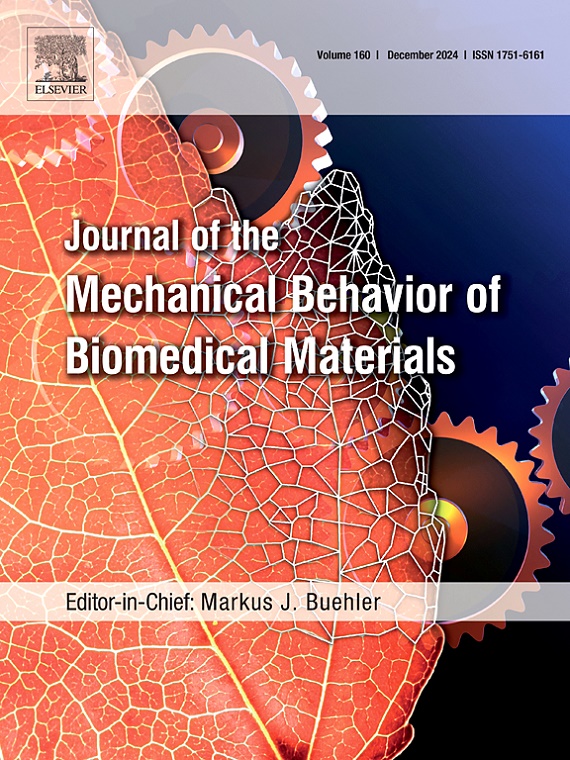PEKK -单片氧化锆悬臂式三单元种植体支撑假体的生物力学行为:有限元研究。
IF 3.3
2区 医学
Q2 ENGINEERING, BIOMEDICAL
Journal of the Mechanical Behavior of Biomedical Materials
Pub Date : 2024-12-17
DOI:10.1016/j.jmbbm.2024.106872
引用次数: 0
摘要
目的:评价不同设计的悬臂式三单元种植体在两种不同材料和不同载荷条件下的生物力学性能。方法:采用两种材料(氧化锆和PEKK)制作了三个不同种植体位置的下颌模型,以支持三单元假体,形成三种不同的设计:远端悬臂式(M1),固定-固定式(M2)和近端悬臂式(M3)。几何模型是通过使用Mimics软件对无牙下颌骨的CBCT扫描进行分割创建的,然后在3-Matic中进行细化,生成由2mm厚的皮质壳和1mm厚的粘膜层包裹的小梁骨核心。整合植入体CAD文件,在SolidWorks中对模型进行处理,最终确定实体几何形状。然后将这些输入到ANSYS中进行网格生成和有限元分析,假设材料是各向同性和弹性的。模型采用垂直100 N、30°斜向50 N、45°斜向50 N 3种不同的静态加载方案,计算Von Mises应力和总变形。结果:模型2表现最佳。在垂直载荷下,PEKK假体的应力低于氧化锆假体(10- 45%)和皮质骨(3- 40%),但种植体的应力高于氧化锆(4- 10%)。与垂直加载相比,斜加载产生了更高的应力,但在不影响功能的安全范围内。结论:固定-固定设计具有最佳的生物力学性能。近端悬臂梁比远端悬臂梁更有利于应力分布。氧化锆提供了优越的应力消散,而PEKK显示了假体的应力减少,但增加了种植体和骨的应力。临床意义:本研究为义齿医师推荐3单元种植体支持义齿的设计和材料提供了依据。氧化锆是悬臂式设计的理想材料,可以抵抗高弯曲力并将种植体应力降至最低,而PEKK则更适合于应力水平较低的固定-固定设计。本文章由计算机程序翻译,如有差异,请以英文原文为准。
Biomechanical behavior of cantilevered 3-unit implant-supported prostheses made of PEKK and monolithic zirconia: A finite element study
Objective
To evaluate the biomechanical performance of various designs of cantilevered three-unit implant-supported prostheses, using two distinct prosthetic materials and under different loading conditions.
Method
Three mandibular models were created with varying implant positions to support a 3-unit prosthesis using two materials (Zirconia and PEKK), resulting in three different designs: distal cantilever (M1), fixed-fixed (M2), and mesial cantilever (M3). The geometric model was created by segmenting a CBCT scan of an edentulous mandible using Mimics software, followed by refinement in 3-Matic to generate a trabecular bone core encased by a 2 mm-thick cortical shell and a 1 mm-thick mucosal layer. Implant CAD files were integrated, and the models were processed in SolidWorks to finalize solid geometries. These were then imported into ANSYS for mesh generation and finite element analysis, with materials assumed to be isotropic and elastic. Models underwent 3 different static loading protocols (Vertical 100 N, 30° Oblique 50 N, 45° Oblique 50 N). Von Mises stress and total deformation were calculated.
Results
Model 2 demonstrated the best performance. Under vertical loading, PEKK prostheses showed lower stress than zirconia in the prosthetic body (10–45 %) and the cortical bone (3–40 %), but higher stresses in the implant (4–10 %). Compared to vertical loading, oblique loading generated higher stress but remained within a safe range without compromising function.
Conclusion
The fixed-fixed design showed optimal biomechanical performance. The mesial cantilever was more favorable than the distal for stress distribution. Zirconia provided superior stress dissipation, while PEKK showed reduced stress in the prosthetic body but increased stress I the implant and bone.
Clinical significance
The study provides prosthodontists with evidence recommending design and materials for 3-unit implant-supported prostheses. Zirconia is ideal for cantilevered designs, resisting high bending forces and minimizing implant stress, while PEKK is more suitable for fixed-fixed designs with lower stress levels.
求助全文
通过发布文献求助,成功后即可免费获取论文全文。
去求助
来源期刊

Journal of the Mechanical Behavior of Biomedical Materials
工程技术-材料科学:生物材料
CiteScore
7.20
自引率
7.70%
发文量
505
审稿时长
46 days
期刊介绍:
The Journal of the Mechanical Behavior of Biomedical Materials is concerned with the mechanical deformation, damage and failure under applied forces, of biological material (at the tissue, cellular and molecular levels) and of biomaterials, i.e. those materials which are designed to mimic or replace biological materials.
The primary focus of the journal is the synthesis of materials science, biology, and medical and dental science. Reports of fundamental scientific investigations are welcome, as are articles concerned with the practical application of materials in medical devices. Both experimental and theoretical work is of interest; theoretical papers will normally include comparison of predictions with experimental data, though we recognize that this may not always be appropriate. The journal also publishes technical notes concerned with emerging experimental or theoretical techniques, letters to the editor and, by invitation, review articles and papers describing existing techniques for the benefit of an interdisciplinary readership.
 求助内容:
求助内容: 应助结果提醒方式:
应助结果提醒方式:


